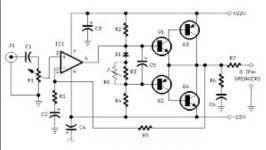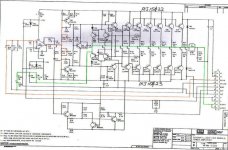Here is something different.
I was in the same boat some months ago. I did something really cool but discovered I actually just got lucky that the circuit worked. This little arrangement I saw recently and while I have not actually tried it, I did try an LM1875 paired to a sziklai pair (quad) output. While I did see the very evident sine output on my scope it looked like there were some spikes assailing the output stage, (image on screen was bouncing around). I am planning to match my output devices and try the circuit again. I used only 220 ohm resistors on the drivers from both rails and 2 diodes on the base of the sziklai input base with output from opamp connected center of those 2 diodes.
The second circuit is to express the idea I tested with sketchy results but may be refined for a very simple poweramp? Will be testing more soon so I guess we will see. Is this something along the lines of what you were asking about or is this 500W PA amplifier with Limiter more suited?
I was in the same boat some months ago. I did something really cool but discovered I actually just got lucky that the circuit worked. This little arrangement I saw recently and while I have not actually tried it, I did try an LM1875 paired to a sziklai pair (quad) output. While I did see the very evident sine output on my scope it looked like there were some spikes assailing the output stage, (image on screen was bouncing around). I am planning to match my output devices and try the circuit again. I used only 220 ohm resistors on the drivers from both rails and 2 diodes on the base of the sziklai input base with output from opamp connected center of those 2 diodes.
The second circuit is to express the idea I tested with sketchy results but may be refined for a very simple poweramp? Will be testing more soon so I guess we will see. Is this something along the lines of what you were asking about or is this 500W PA amplifier with Limiter more suited?
Attachments
I like it when they use the first op amp as a differential receiver, for twisted pair lines using stereo phone plugs. That cuts hum over 12' of rca cable I use with the ST120 djoffe.
Peavey CS800x & CS800s go from diff input op amp to a 4560 op amp as VAS to voltage gain predriver then double Emitter follower. There's an 800x on louisville craigslist today for $100. I'm listening to an S now that I repaired.
I'm down on LM1875. I built 2 and they motorboated irrepairably on point to point boards. Yeah, I can buy the dual supply speaker burner boards on ebay for $2. NOBODY had the capacitor coupled layout. All the 24 to 36 v transformers I have don't have a center tap, either
Building an Old Fashioned Max from Elvee now, P to P. That won't burn my $600 (new) speakers. Don't need a center tap.
The cs800s & cs800x have DC detection built in, and speaker disconnect relays. Enzo said they really work; haven't need my relays yet.
Peavey CS800x & CS800s go from diff input op amp to a 4560 op amp as VAS to voltage gain predriver then double Emitter follower. There's an 800x on louisville craigslist today for $100. I'm listening to an S now that I repaired.
I'm down on LM1875. I built 2 and they motorboated irrepairably on point to point boards. Yeah, I can buy the dual supply speaker burner boards on ebay for $2. NOBODY had the capacitor coupled layout. All the 24 to 36 v transformers I have don't have a center tap, either
Building an Old Fashioned Max from Elvee now, P to P. That won't burn my $600 (new) speakers. Don't need a center tap.
The cs800s & cs800x have DC detection built in, and speaker disconnect relays. Enzo said they really work; haven't need my relays yet.
Last edited:
Lm318 front end. Bet that hisses as bad as the 741 in CS800 rev A & B.look BGW 750B schematic, LM318 Front End, will work very stable
From your Listening Throne
Actually, probably not all that bad, for a POWER amp. Unacceptable for a preamp or worse for either a microphone input or worst, a magnetic phono cartridge RIAA network.
But look at page 7 - http://www.ti.com/lit/ds/symlink/lm318-n.pdf
And do the math:
I wouldn't call that an audible hiss. There's WAY more random room noise in even the better listening areas that I've been treated to.
However, the noise floor IS a floor: it remains a near-constant regardless of input signal. Let's say our LM318 stage is delivering 20× gain, and the following complementary power output stage, another 2× gain. 40× overall, raising a nominal 1 VRMS to 40 VRMS. Which into 8 Ω is
But its still not something you'd be perceiving from your sweet-spot listening throne.
Just Saying,
-= GoatGuy ✓ =-
Lm318 front end. Bet that hisses as bad as the 741 in CS800 rev A & B.
Actually, probably not all that bad, for a POWER amp. Unacceptable for a preamp or worse for either a microphone input or worst, a magnetic phono cartridge RIAA network.
But look at page 7 - http://www.ti.com/lit/ds/symlink/lm318-n.pdf
And do the math:
√( 20,000 Hz ÷ 20 Hz ) = 31 or so,
31 × 16 nV … = 500 nV audio-band input noise.
If the 318 signal input is at 1.0 VRMS, then the noise floor is about –120 dB from signal. 31 × 16 nV … = 500 nV audio-band input noise.
I wouldn't call that an audible hiss. There's WAY more random room noise in even the better listening areas that I've been treated to.
However, the noise floor IS a floor: it remains a near-constant regardless of input signal. Let's say our LM318 stage is delivering 20× gain, and the following complementary power output stage, another 2× gain. 40× overall, raising a nominal 1 VRMS to 40 VRMS. Which into 8 Ω is
P = ERMS² / R
P = 40² ÷ 8
P = 200 W
So a rather NICE power amplifier! OK…P = 40² ÷ 8
P = 200 W
VN-OUT = VN-IN • gain
VN-OUT = 500 nV × 40
VN-OUT = 20,000 nV
VN-OUT = 20 µV
VN-OUT = 0.020 mV
VN-OUT = 0.000020 V
and ifVN-OUT = 500 nV × 40
VN-OUT = 20,000 nV
VN-OUT = 20 µV
VN-OUT = 0.020 mV
VN-OUT = 0.000020 V
P = ERMS² / R
P = 0.000020² ÷ 8
P = 5×10⁻¹¹ W
and that relative to 1 watt (for speaker conversion)P = 0.000020² ÷ 8
P = 5×10⁻¹¹ W
dB = 10 log10( P / PREF )
dB = 10 log10( 5×10⁻¹¹ ÷ 1.0 );
dB = –103
… now if we bump in a set of really efficient 110 dB/W speakers, dB = 10 log10( 5×10⁻¹¹ ÷ 1.0 );
dB = –103
SPL = dBW speaker sensitivity + dBW power to them
SPL = 110 + (–103)
SPL = 7 dB (audio);
Which is at 1 meter. You could 'improve' upon that by getting your ear really, realy close to the tweeter (within a couple of inches), and get to 40 dB or so. SPL = 110 + (–103)
SPL = 7 dB (audio);
But its still not something you'd be perceiving from your sweet-spot listening throne.
Just Saying,
-= GoatGuy ✓ =-
Thanks for the analysis. Never know how to compare microvolt noise figures to sqrthz noise figures.Actually, probably not all that bad, for a POWER amp.
-= GoatGuy ✓ =-
A 4558 is 1.4 microv typical, which is triple 500 nv.
4560 in CS800s that I'm listening to right now TI says is typical 1.2 microv @ 2000 ohm source impedance, which is about what I'm feeding with. ST33078 as line drivers in a modified RA-88a mixer. Nice & quiet at 1 W output into 102 db 1w1m speakers, except for a little hum on left channel. Peavey used JRC4560 instead of TI, there might be a reason besides cost.
Bought a used PV8 mixer Monday which will drive 4 m twisted pair TRS cables to the CS800s, instead of the 4 m RCA plug cables I'm using now. That might reduce the hum. PV8 uses rohm 4562 op amps.
Last edited:
Hi Freecrowder,
Quite a coincidence. I recently ordered some PCB's for such an amp.It is a very
simple configuration with an NE5532 in the front, each half driving one channel,
and the current is supplied to the speaker by means of a CFP pair biased by 2
diodes fed by 2*2 resistors providing bootstrapped drivers for the CFP's. I hope
to receive the boards before the end of January.The amp will run from a
2*12V transformer and will provide around 8 Watts of power per channel.
The board houses 2 channels plus the power supply. If you are interested,
please send me your postal address to selim_ardali at yahoo.com.
Happy 2020 everybody
Selim
Quite a coincidence. I recently ordered some PCB's for such an amp.It is a very
simple configuration with an NE5532 in the front, each half driving one channel,
and the current is supplied to the speaker by means of a CFP pair biased by 2
diodes fed by 2*2 resistors providing bootstrapped drivers for the CFP's. I hope
to receive the boards before the end of January.The amp will run from a
2*12V transformer and will provide around 8 Watts of power per channel.
The board houses 2 channels plus the power supply. If you are interested,
please send me your postal address to selim_ardali at yahoo.com.
Happy 2020 everybody
Selim
Only one problem, you got the maths wrong.And do the math:√( 20,000 Hz ÷ 20 Hz ) = 31 or so,If the 318 signal input is at 1.0 VRMS, then the noise floor is about –120 dB from signal.
31 × 16 nV … = 500 nV audio-band input noise.
BW = 20000 - 20 = 19980, √19980 ~= 141
16nV x 141 = 2.25µV rms
[ you divided frequencies by mistake ]
So 113dB down from 1V rms, ignoring source resistance / current noise.
Only one problem, you got the maths wrong.
BW = 20000 - 20 = 19980,
√19980 ≈ 141
16nV x 141 = 2.25µV rms
[ you divided frequencies by mistake ]
So 113dB down from 1V rms, ignoring source resistance / current noise.
Johnson–Nyquist noise - Wikipedia
So … you are right. You know what happens to milk if you leave it sit about for some time? It sours. Memories are similar, but with (usually) a longer decay time. Mine is some gazillion years old.
I think the reason I got it in my head that it was a BW = HI/LO kind of thing was because of the radical part. No matter. Wrong is wrong, no matter how cheesy the milk smells.
And yes, being off by essentially a factor of 20 log10( √(20) ) = +13.0 definitely skews things. But not TOO much! I think that “is good enough for a conventional monoblock power amplifier” is still likely the right opinion.
Just Saying,
-= GoatGuy ✓ =-
PS - ⊕5 if I could … 'cuz you used the right symbols. √ … ≈ … µV
Last edited:
look BGW 750B schematic, LM318 Front End, will work very stable
Almost any bgw for that matter, popular model 250 runs on 55+/-, sounds better than it should.
- Status
- This old topic is closed. If you want to reopen this topic, contact a moderator using the "Report Post" button.
- Home
- Amplifiers
- Solid State
- Power amp w/ Opamp front end.


